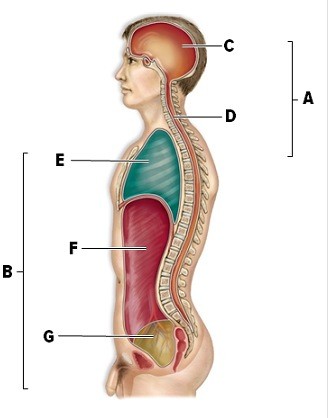Name the labeled cavities in the diagram at right and indicate an organ found in each.
What will be an ideal response?
A - Dorsal Cavity: contains the cranial and vertebral cavity
B - Ventral Cavity: contains the thoracic, abdominal and pelvic cavity
C - Cranial Cavity: contains the brain
D - Vertebral Cavity: contains the spinal cord
E - Thoracic Cavity: contains esophagus, heart and lungs
F - Abdominal Cavity: contains digestive organs, the liver, pancreas and other organs
G - Pelvic Cavity: contains reproductive organs, urinary bladder, and other organs
You might also like to view...
Which of the following statements is true in eukaryotic cells?
A. Transcription occurs in the cytoplasm, and translation occurs in the nucleus. B. Transcription and translation both occur in the nucleus. C. Transcription occurs in the nucleus, and translation occurs in the cytoplasm. D. Transcription and translation both occur in the cytoplasm.
Which statement is a part of the first law of thermodynamics?
a. Energy can be neither created nor destroyed.
b. Energy cannot be transformed. c. The entropy of the universe is constant. d. The entropy of the universe is decreasing. e. Potential energy is the energy of motion.
The Hayflick limit describes ____
A. the size limit to which a cell can grow B. the number of divisions a cultured cell can undergo C. the largest number of chromosomes an organism can possess D. the most cells an organism can have E. how rapidly DNA replication occurs
________ are characterized body tissues, radial symmetry, and tentacles with stinging cells.
A) Annelids B) Sponges C) Cnidarians D) Roundworms